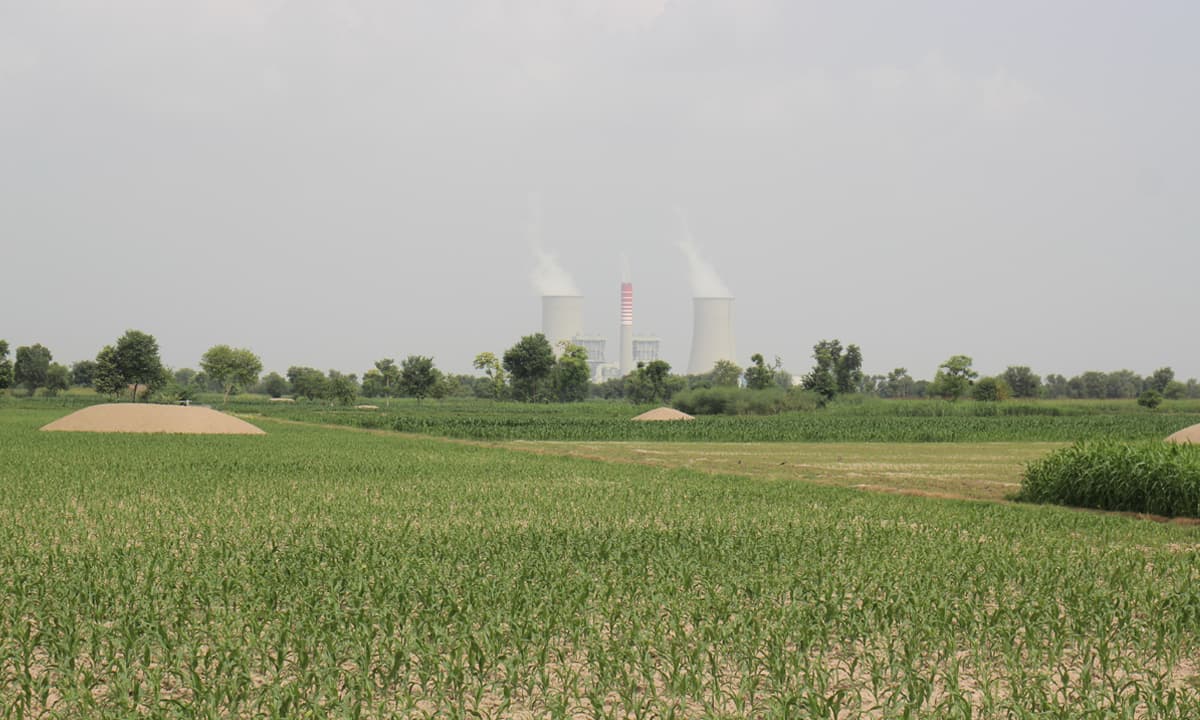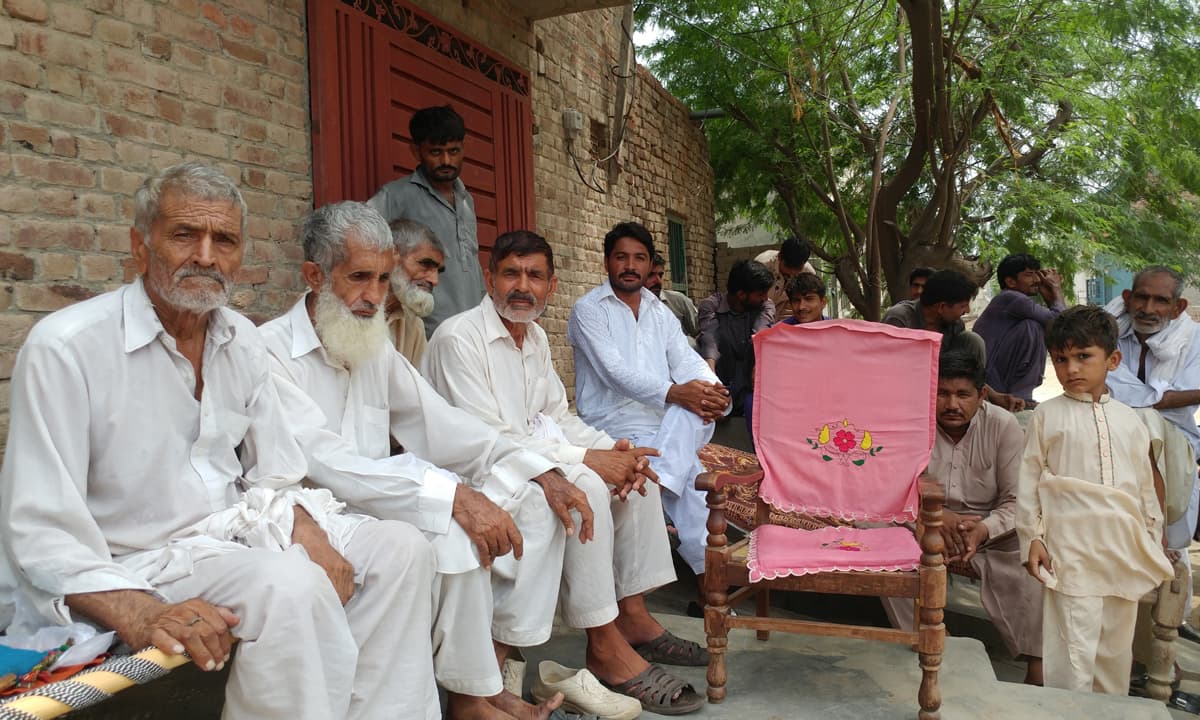
It is a hot and humid day and the electricity is out in the small village of Chak 76-5R. Local lambardar, Tariq Tufail, is sitting on a charpoy outside his house surrounded by other villagers. They are using Chinese handheld fans to cool themselves. The irony is that the village is located under the shadow of a newly set-up coal power plant owned by a Chinese firm, Huaneng Shandong Ruyi.
Chak 76-5R is part of Sahiwal district where canal-irrigated farming is the mainstay of the local economy. Many farmers in the village, however, had to give up their farmland to make way for the power plant.
“It was coercion,” claims Tufail as he recalls the process of land acquisition. Farmers, he says, were “blackmailed” into giving up their land. “The government officials came one night, put the resisting villagers in a van and took them to a police station where anti-terrorism cases were registered against them,” he alleges. “Some of them are still fighting those cases in court.”
Older residents of the village have been dependent on the land to make a living. They know no other skills. But they had to accept the compensation – 2,070,000 rupees per acre – given to them by the authorities, and make do with whatever land they were left with.
To mitigate their suffering, the government promised to give them jobs the plant would generate. For a while, the promise was also fulfilled. During the plant’s construction there were plenty of jobs for local young men to work as labourers. Once the plant became functional, their services were no longer needed since running it required specialised and skilled labour that the villagers could not offer.
Then there came an additional worry: the water table in the area started falling due to its usage in the plant’s operations. The villagers claim water has receded by about 15 feet since construction for the plant began two years ago.
Though evidence for recession in the water table is largely anecdotal, the plant does require a large amount of water when it is running. Its feasibility report – prepared by the firm that owns it and submitted to the National Electric Power Regulatory Authority (Nepra) – states that it uses around 49,850 litres of water per minute (or 29 cubic feet per second). This water is being drawn from Lower Bari Doab Canal which, according to the Punjab irrigation department, has an average flow of 7,000 cubic feet per second in Sahiwal district. Huaneng Shandong Ruyi pays for the canal water it uses. Last year, it paid 10.8 million rupees to the irrigation department in water prices.
When the canal is closed down – for 15 days in October-November and for 45 days in December-January every year – the plant extracts the same amount of water, 29 cubic feet per second, from two underground wells dug on its premises. The feasibility report claims this extraction will have no adverse effect on the water table as nature will each year replenish at least half of the total water extracted.
Farmers living around the plant complain that the withdrawal of water from the canal in any case means that they are receiving less water for irrigation from the canal than they used to. This, they say, is making them heavily reliant on underground water. Some of them have installed their own diesel-run tube wells; others have to buy irrigation water from their neighbours. This has increased their expenses on farming, they say.
Tufail has nothing to do these days except wait for the situation to somehow improve. “The young ones can still do something else. At 64, I do not know what to do.”
When Nawaz Sharif’s government came into power five years ago, it introduced a new power policy aimed at increasing electricity production and decided to set up many new power projects. To be added to the national grid by 2026, these include 14 coal-fired power plants, three plants that run on regasified liquefied natural gas (RLNG) and seven hydro-electric projects.
Not all of these will be built by the end of the day. One of them, a 700 megawatt coal-fired one – to be built by a joint venture of a consortium of Chinese companies and K-Electric – is said to have been shelved even though it still features on the latter’s website.
Out of all the projects announced since 2013, two running on coal and two using RLNG have started producing electricity already. The rest are at various stages of construction or approval from the government.
All this flurry of plant building has increased Pakistan’s installed capacity to produce electricity by 30 per cent since 2013. According to the Economic Survey of Pakistan for 2017-18, the country can now produce 29,573 megawatts of electricity — though actual production could be much less because of financial and other logistical, technical and natural constraints.
The increase in electricity production has happened as a result of foreign, almost exclusively Chinese, investment in the sector. To encourage this investment, the government had to announce many incentives that have come under criticism from many people.
Syed Akhtar Ali, a former member of the Planning Commission of Pakistan, says the investment required to set up a power plant is very high — to the tune of two billion US dollars. Since most Pakistani investors do not have this kind of financial pull, the government announced that it will exempt foreign investment in electricity generation from various taxes. The investors were also allowed to bring the required machinery into Pakistan at just five per cent import tax.
To make the investment opportunities more attractive, the government guaranteed that it will pay the power producers as per their capacity rather than actual generation of electricity by them. A private power producer will, thus, get paid even if it produces no electricity at all.
Various Chinese companies have subsequently invested large amounts of money in the power sector. Of the 62 billion US dollars to be invested by China in Pakistan under the China-Pakistan Economic Corridor (CPEC), around 33 billion US dollars are allocated for the energy sector. Of this, an estimated 15 billion US dollars are to be invested in new coal-fired power plants alone.

Documents obtained from Nepra show that a total of 12 coal power plants will be built between 2013 and 2019 with Chinese money. Eight of these are to be owned by Chinese companies. Two of them, one in Sahiwal and the other at Port Qasim, Karachi, have already become functional.
“The whole process is a bit incestuous,” says Karachi-based economist Kaiser Bengali of the Chinese investment in coal-based power generation in Pakistan. Chinese companies will purchase plant machinery and other equipment from other Chinese companies with loans taken from Chinese banks. Even when projects are funded by Pakistani banks or undertaken by local companies, it is Chinese firms that provide engineering, procurement and construction services, he says, largely because Pakistan does not have the required expertise in these fields.
All Chinese investments in the power sector, in turn, are insured by the Sinosure Bank in China. The standard rate for this insurance is seven per cent of the entire cost of a project. When calculating tariff for a power plant, this amount gets included in the price at which consumers will buy electricity.
The insurance requirement, though, is not specific to Chinese investment in Pakistan, Ali says. It is a standard practice for most international lending in any country, he adds.
Another additional cost for all CPEC-related projects is the money being spent on the security of their Chinese staff — about one per cent of the cost of each project. This, too, is being added to the final tariff in the case of power plants.
Bengali points to another issue with the power policy: high rate of return promised to investors. The plant in Sahiwal has a return on equity – net income earned as percentage of invested money – of almost 27 per cent.
But the problem, as Bengali argues, is not with Chinese investment per se but the financial model being followed. There is the example of a power policy announced in 1994 that facilitated a large amount of foreign investment from the United States – not dissimilar to the Chinese investment now – through Independent Power Producers (IPP). But the change in government in 1997 resulted in corruption investigations into contracts with those IPPs. Legal notices were issued to 11 of them, leading to a halt in their electricity production. By 1998, the entire policy had collapsed.
One of the many reasons for its collapse was Pakistan’s highly vulnerable financial situation. As a result of economic sanctions imposed by the United States after Pakistan’s nuclear tests of May 1998, balance of payments deteriorated rapidly and foreign investment slowed down. The rupee depreciated by 25 per cent and dollar reserves declined alarmingly – shrinking to the equivalent of less than two weeks of imports. There was no money to be paid to IPPs. Eventually, the World Bank had to step in to resolve the crisis.
Now that Pakistan is passing through an eerily similar financial situation, any small setback can hurt investment worth billions of dollars in the power sector.
Ali sees all the concessions to the investors as the price Pakistan has to pay for foreign investment in coal — a fuel that most countries are not willing to invest in because of environmental concerns. “China itself is shifting away from coal,” he says.
Pakistan is seeking to utilise coal in order to avoid the high financial cost of electricity produced through imported oil.
Coal, though, exacts another price. It pollutes the environment like no other fuel does. According to some studies, a 30 per cent increase in greenhouse gas emissions from electricity production has already been witnessed in Pakistan between 1990 and 2012. With the introduction of coal-fired power plants, this figure is likely to rise even further.
The writer is a staffer at the Herald.
This article was published in the Herald's September 2018 issue. To read more subscribe to the Herald in print.










